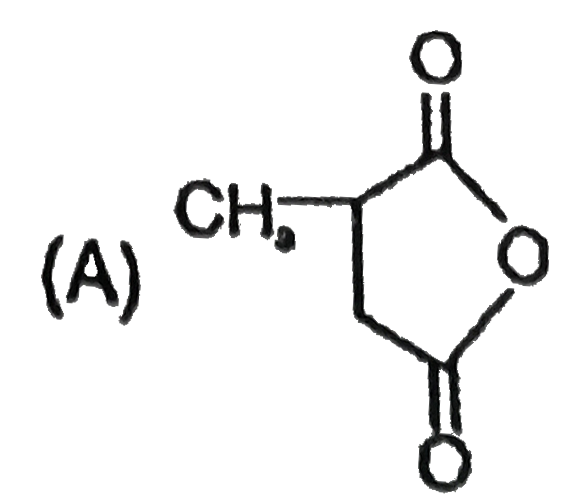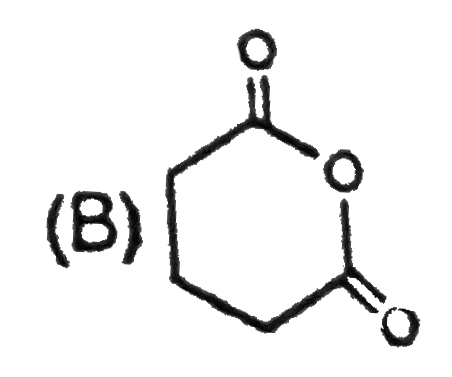A hydrocarbon (X) of the formula C6H12 does not react with bromine water but reacts with bromine in presence of light, forming compound (Y).Compound (Y) on treatment with Alc. KOH gives compound (Z) which on ozonolysis gives (T) reduces Tollens reagent which gives compound (W) after acidification . (W) gives iodoform test and after acidification produce compound (U) which when heated with P2O5 forms a cyclic anhydride (V).
Compound V is


CH3−O∣∣C−CH2−CH2−CH=O
CHO−CH=CH−CHO
The correct Answer is:B
To solve the problem step-by-step, we will analyze each part of the question systematically.
Step 1: Identify Hydrocarbon (X)
The hydrocarbon (X) has the formula C6H12 and does not react with bromine water. This indicates that it is a saturated hydrocarbon, which means it is an alkane.
Hint: Saturated hydrocarbons do not react with bromine water because they do not have double or triple bonds.
Step 2: Reaction with Bromine in Presence of Light
Since (X) reacts with bromine in the presence of light, it undergoes a free radical substitution reaction. This suggests that (X) could be a cyclic alkane, likely a cyclohexane with a methyl group (e.g., methylcyclopentane).
Hint: Free radical substitution occurs in alkanes when exposed to light, leading to the formation of brominated products.
Step 3: Formation of Compound (Y)
Upon reacting with bromine, compound (Y) is formed by the substitution of a hydrogen atom with a bromine atom at a tertiary position in the cyclic structure.
Hint: The product of the bromination will depend on the stability of the radicals formed during the reaction.
Step 4: Reaction of Compound (Y) with Alcoholic KOH
When compound (Y) is treated with alcoholic KOH, an elimination reaction occurs, resulting in the formation of compound (Z), which is an alkene. The major product will have more hyperconjugation.
Hint: Alcoholic KOH promotes elimination reactions, leading to the formation of alkenes.
Step 5: Ozonolysis of Compound (Z)
Compound (Z) undergoes ozonolysis, which cleaves the double bond and forms compound (T) with carbonyl groups.
Hint: Ozonolysis typically yields aldehydes or ketones depending on the structure of the alkene.
Step 6: Reaction of Compound (T) with Tollens Reagent
Compound (T), which contains an aldehyde functional group, reduces Tollens reagent, resulting in the formation of compound (W).
Hint: Tollens reagent is used to test for aldehydes, which are oxidized to carboxylic acids.
Step 7: Iodoform Test with Compound (W)
Compound (W) gives a positive iodoform test, indicating the presence of a methyl ketone or an alcohol adjacent to a carbonyl group. This leads to the formation of compound (U).
Hint: The iodoform test is specific for methyl ketones and certain alcohols.
Step 8: Heating Compound (U) with P2O5
When compound (U) is heated with P2O5, a cyclic anhydride (V) is formed.
Hint: P2O5 is a dehydrating agent that can promote the formation of anhydrides from carboxylic acids.
Step 9: Identify Compound (V)
The cyclic anhydride (V) formed has a structure that can be drawn based on the previous compounds. It will have a six-membered ring with two carbonyl groups.
Final Conclusion: The compound (V) is a cyclic anhydride, specifically phthalic anhydride.
Final Answer: Compound (V) is phthalic anhydride.
The hydrocarbon (X) has the formula C6H12 and does not react with bromine water. This indicates that it is a saturated hydrocarbon, which means it is an alkane.
Since (X) reacts with bromine in the presence of light, it undergoes a free radical substitution reaction. This suggests that (X) could be a cyclic alkane, likely a cyclohexane with a methyl group (e.g., methylcyclopentane).
Upon reacting with bromine, compound (Y) is formed by the substitution of a hydrogen atom with a bromine atom at a tertiary position in the cyclic structure.
When compound (Y) is treated with alcoholic KOH, an elimination reaction occurs, resulting in the formation of compound (Z), which is an alkene. The major product will have more hyperconjugation.
Compound (Z) undergoes ozonolysis, which cleaves the double bond and forms compound (T) with carbonyl groups.
Compound (T), which contains an aldehyde functional group, reduces Tollens reagent, resulting in the formation of compound (W).
Compound (W) gives a positive iodoform test, indicating the presence of a methyl ketone or an alcohol adjacent to a carbonyl group. This leads to the formation of compound (U).
When compound (U) is heated with P2O5, a cyclic anhydride (V) is formed.
The cyclic anhydride (V) formed has a structure that can be drawn based on the previous compounds. It will have a six-membered ring with two carbonyl groups.
Topper's Solved these Questions
Similar Questions
Knowledge Check
The compound which does not give iodoform test is
AAcetophenoneBBenzophenoneCCH3C∣CH3HOHDCH3−C∣OHH−CH2CH2CH3The compound which does not give iodoform test is
AAcetophenoneBBenzophenoneCCH3C∣CH3HOHDCH3−C∣OHH−CH2CH2CH3The compound which does not give iodoform test is
AAcetophenoneBBenzophenoneCCH3C∣CH3HOHDCH3−C∣OHH−CH2CH2CH3
Compound (X) of molecular formula C4H8 takes up one equivalent of hydrogen in presence of Pt to form another compound (Y),(X) on ozonolysis gives acetaldehyde as the only product. Compound (X) is
View SolutionThe compound which does not give iodoform on treatment with NaOH and iodine is
View SolutionThe compound which does not give iodoform on treatment with NaOH and iodine is
View SolutionThe compound which does not give iodoform on treatment with NaOH and iodine is
View SolutionPrimary alkyl halide C4H9Br (X) reacts with alc. KOH to give compound (Y). (Y) reacts with HBr to give compound (Z) which is an isomer of (X). When (X) reacts with Na metal it gives compound (P). (X), (Y), (Z) and (P) are
View Solution